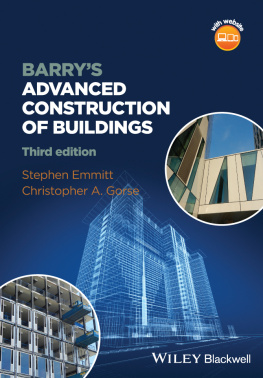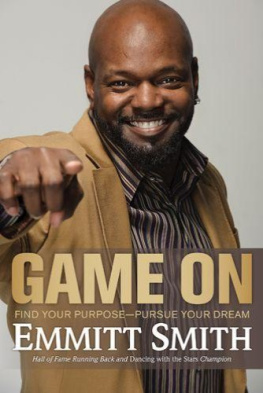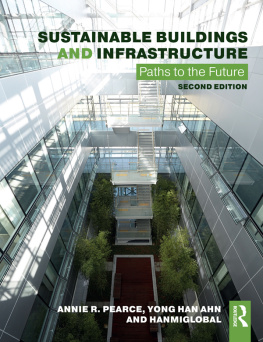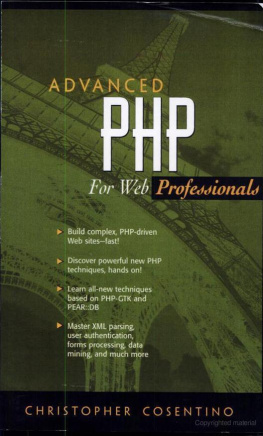Emmitt Stephen Gorse Christopher A. - Barrys Advanced Construction of Buildings
Here you can read online Emmitt Stephen Gorse Christopher A. - Barrys Advanced Construction of Buildings full text of the book (entire story) in english for free. Download pdf and epub, get meaning, cover and reviews about this ebook. year: 2014, publisher: Wiley, genre: Home and family. Description of the work, (preface) as well as reviews are available. Best literature library LitArk.com created for fans of good reading and offers a wide selection of genres:
Romance novel
Science fiction
Adventure
Detective
Science
History
Home and family
Prose
Art
Politics
Computer
Non-fiction
Religion
Business
Children
Humor
Choose a favorite category and find really read worthwhile books. Enjoy immersion in the world of imagination, feel the emotions of the characters or learn something new for yourself, make an fascinating discovery.
- Book:Barrys Advanced Construction of Buildings
- Author:
- Publisher:Wiley
- Genre:
- Year:2014
- Rating:4 / 5
- Favourites:Add to favourites
- Your mark:
- 80
- 1
- 2
- 3
- 4
- 5
Barrys Advanced Construction of Buildings: summary, description and annotation
We offer to read an annotation, description, summary or preface (depends on what the author of the book "Barrys Advanced Construction of Buildings" wrote himself). If you haven't found the necessary information about the book — write in the comments, we will try to find it.
Barrys Advanced Construction of Buildings — read online for free the complete book (whole text) full work
Below is the text of the book, divided by pages. System saving the place of the last page read, allows you to conveniently read the book "Barrys Advanced Construction of Buildings" online for free, without having to search again every time where you left off. Put a bookmark, and you can go to the page where you finished reading at any time.
Font size:
Interval:
Bookmark:


This edition first published 2014
Third edition 2014 by John Wiley & Sons, Ltd
Registered office: John Wiley & Sons, Ltd, The Atrium, Southern Gate, Chichester, West Sussex, PO19 8SQ, UK
Editorial offices: 9600 Garsington Road, Oxford, OX4 2DQ, UK
The Atrium, Southern Gate, Chichester, West Sussex, PO19 8SQ, UK
For details of our global editorial offices, for customer services and for information about how to apply for permission to reuse the copyright material in this book please see our website at www.wiley.com/wiley-blackwell.
The right of the author to be identified as the author of this work has been asserted in accordance with the UK Copyright, Designs and Patents Act 1988.
All rights reserved. No part of this publication may be reproduced, stored in a retrieval system, or transmitted, in any form or by any means, electronic, mechanical, photocopying, recording or otherwise, except as permitted by the UK Copyright, Designs and Patents Act 1988, without the prior permission of the publisher.
Designations used by companies to distinguish their products are often claimed as trademarks. All brand names and product names used in this book are trade names, service marks, trademarks or registered trademarks of their respective owners. The publisher is not associated with any product or vendor mentioned in this book. This publication is designed to provide accurate and authoritative information in regard to the subject matter covered. It is sold on the understanding that the publisher is not engaged in rendering professional services. If professional advice or other expert assistance is required, the services of a competent professional should be sought.
Library of Congress Cataloging-in-Publication Data
Emmitt, Stephen.
Barry's advanced construction of buildings / Stephen Emmitt and Christopher A. Gorse. Third edition.
1 online resource.
Includes bibliographical references and index.
Description based on print version record and CIP data provided by publisher; resource not viewed.
ISBN 978-1-118-87071-6 (ePub) ISBN 978-1-118-87083-9 (Adobe PDF) ISBN 978-1-118-25549-0 (pbk.) 1. Building. I. Barry, R. (Robin) II. Gorse, Christopher A. III. Title. IV. Title: Advanced construction of buildings.
TH146
690dc23
2014002857
A catalogue record for this book is available from the British Library.
Wiley also publishes its books in a variety of electronic formats. Some content that appears in print may not be available in electronic books.
Cover image courtesy of the authors and iStock Photo
Cover design by Andy Meaden
Over the years our students have continued to be the inspiration for writing books and they deserve our heartfelt credit for helping to keep our feet firmly on the ground by asking the why and how questions. Feedback from our readers and reviewers also helps us to keep the Barry series relevant and topical. It would, of course, be an impossible task to write this book without the support and assistance of our colleagues in academia and constant interaction with industry, for which we are extremely grateful. We would like to mention and thank Mike Armstrong (Shepherd Group), Joanne Bridges (Yorkon), Mikkel Kragh (Dow Corning), Shaun Long (Rossi Long Consulting), Karen Makin (Roger Bullivant), Jennifer Muston (Rockwool B.V. / Rockpanel Group), Gordon Throup (Big Sky Contracting) and Paul Wilson (Interserve). We would also like to thank the numerous other individuals and organisations, many of whom have been very generous with their time, allowing access for photography and giving valuable advice. We trust a global acknowledgement of our gratitude will go some way to acknowledge their collective help.
This book's companion website is at www.wiley.com/go/barrysintroduction and offers invaluable resources for students and lecturers:

Introduction
In Barry's Introduction to Construction of Buildings we provided an introductory chapter that set out some of the basic requirements and conditions relevant to all building projects, regardless of size and complexity. In this volume the emphasis shifts from domestic to larger-scale buildings, primarily residential, commercial and industrial buildings constructed with loadbearing frames. This is supported with information on fit out and second fix, lifts and escalators, and off-site construction. Many of the principles and techniques set out in the introductory volume are, however, still appropriate to this volume. Similarly, many of the technologies described here are also used in smaller buildings. Thus we would urge readers to consult both volumes of the Barry series. In this introductory chapter we start to address some additional, yet related, issues, again with the aim of providing some context to the chapters that follow.
In Barry's Introduction to Construction of Buildings, we set out some of the fundamental functional and performance requirements of buildings. We continue the theme here with some additional requirements applicable to the construction of buildings, regardless of type, size or complexity.
Structure and building fabric have a very special relationship. It is the combined performance of the structure and building fabric, together with the integration of services, which determines the overall performance of the building during its life. In loadbearing construction, the materials forming the structural support also provide the fabric and hence the external and internal finishes. In framed structures, the fabric is independent of the structure, with the fabric applied to the loadbearing structural frame.
Buildings need to accommodate the loads and forces acting on them if they are to resist collapse. One of the most important considerations is how forces are transferred within the structure. Buildings are subject to three types of loading:
- Dead loads. Dead loads remain relatively constant throughout the life of a building, unless it is remodelled at a future date. These loads comprise the combined weight of the materials used to construct the building. Loads are transferred to the ground via the foundations. Because the weight of individual components is known, the dead load can be easily calculated.
- Live loads. Unlike dead loads, the live loads acting on a building will vary. Live loads comprise the weight of people using the building, the weight of furniture and equipment, etc. Seasonal changes will result in (temporary) live loading from rainfall and snow. Structural design calculations assume an average maximum live load based on the use of the building (plus a safety factor). If the building use changes, then it will be necessary to check the anticipated live loading against that used at the design stage.
- Wind loads. All buildings are subject to wind loading. Maximum wind loads (gusts) are determined by considering the maximum recorded wind speed in a particular location and adding a safety factor. Wind loading is an important consideration for both permanent and temporary structures. It is also an important consideration when designing and installing temporary weather protection to protect building workers and work in progress from the elements.
Font size:
Interval:
Bookmark:
Similar books «Barrys Advanced Construction of Buildings»
Look at similar books to Barrys Advanced Construction of Buildings. We have selected literature similar in name and meaning in the hope of providing readers with more options to find new, interesting, not yet read works.
Discussion, reviews of the book Barrys Advanced Construction of Buildings and just readers' own opinions. Leave your comments, write what you think about the work, its meaning or the main characters. Specify what exactly you liked and what you didn't like, and why you think so.







